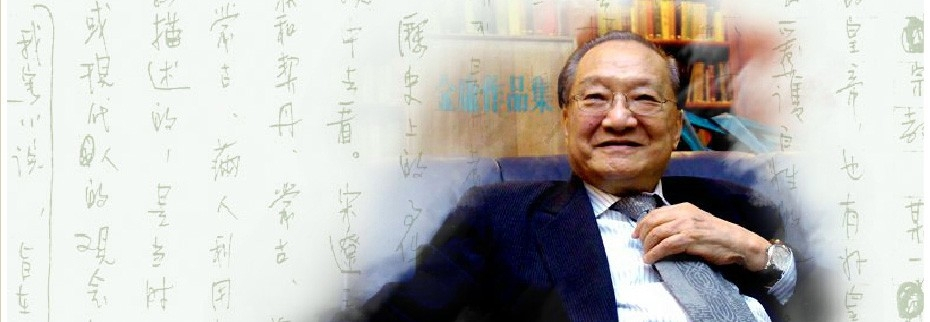
Jin Yong
Splendid
Chi Culture
Topic
Jin Yong
Jin Yong (1924–2018), is the pen name of Zha Liangyong, also known as Louis Cha Leung-yung, who is best known for his martial arts novels, journalism, and social activism. He, along with Gu Long (1938–1985), and Liang Yusheng (1924–2009) are the Three Masters of the Chinese Martial Arts Novels. Jin Yong wrote fifteen of these novels. The first fourteen novels are often referred to by first word of each of their titles: Shooting White Deer in Flying Snow Days; Smilingly Writing the Story of a Chivalrous Swordsman Who Is Leaning Toward the Green Mandarin Ducks”; his fifteenth book is Yuenü jian (Sword of the Yue maiden). His works have won universal praise.
Jin Yong was born to a wealthy scholar-gentry family in Haining county, Jiaxing city, Zhejiang province, in 1924. His grandfather was a successful candidate in the highest imperial civil service examination during the late Qing dynasty (late nineteenth century). His uncle, father, and elder brother all graduated from college and he was raised in a well-educated family. Not only was he among the best in his class since the time he was a young child, but he also developed the habit of reading after school. In 1939, he and his classmate compiled a best-selling study guide called For Candidates Taking the Middle School Entrance-Examination. It can be plainly seen that he started his writing career at a young age. In 1944, Jin Yong was admitted to the National Chengchi University, and later transferred to Soochow University. In 1948, he translated new releases for the Chinese newspaper Ta Kung Pao. Before long, he was assigned to the newspaper’s Hong Kong office.
In 1955, he wrote his first martial arts novel Shu jian enchou lu (The book and the sword). From that time onward, he became famous and his popularity became unmanageable. In 1959, he and his partner jointly established the magazine Ming Pao; he served as the editor-in-chief and publisher for thirty-five years. During this time, he also established several publications, including Ming Pao Monthly, Ming Pao Weekly, Shin Min Daily News in Singapore, and Shin Min Daily News in Malaysia. Newspapers in Hong Kong were a saturated industry and therefore highly competitive. During his tenure as CEO, Ming Pao went from being a small publication to becoming a world-famous newspaper group. In the history of newspapers in Hong Kong, it is considered a miracle and was also one of Jin Yong’s most noteworthy achievements. In 1972, he capped his pen and wrote no more. In 1994, Jin Yong left Ming Pao.
Jin Yong’s lifetime achievements are numerous and were accomplished in diverse arenas such as news media, business, and social activities. But his greatest contribution to the Chinese-speaking world is his creation of a martial arts world. One of the biggest obstacles in martial arts novels is the repetition of the same narrative pattern. Jin Yong consciously and constantly broke this model; this was largely accomplished by creating main characters with different personalities and qualities. Generally speaking, the protagonists in Jin Yong’s novels can be categorized into the following six patterns: the first is the Ruist, represented by Chen Jialuo and Guo Jing; they dedicate themselves to the people and the country; the second is the Daoist who pays attention to his heart, this type of character is represented by Yang Guo and Zhang Wuji; the third is the honest and naïve person represented by Di Yun and Shi Potian; the fourth is the benevolent and compassionate Buddhist represented by Duan Yu; the fifth is the modern freedom-loving persona represented by Linghu Chong; and the sixth is the antihero, represented by Wei Xiaobao. Shu Jian enchou lu, a novel singing the praises of a national hero, describes a great swordsman’s feelings for his family and country; Shendiao xialü (The return of the condor heroes) is a work reflecting the protagonist’s individualism and heartfelt emotion and deep instinct. Xueshan fei hu (Fox volant of the snowy mountain) is a novel about the legend of a chivalrous swordsman, a real old-fashioned gallant who experienced the many vicissitudes of life. Xiake xing (Ode to gallantry) and Liancheng jue (A deadly secret) are two works that describe the hard and miserable life of an honest man and a naïve person. Tianlong babu (Demi-gods and semi-devils) is a work with religious and fable-like significance, in which the author reveals humanity’s tragic fate because of its endless desire. Xiao’ao jianghu (The smiling, proud wanderer) incorporates political satire in a story about the conflict between authoritarian politics and individual freedom. Lu Ding ji (The deer and the cauldron) is a work of cultural and symbolic significance, in which the author directly points out the inherent weaknesses of society.
Jin Yong’s novels elevated the popular martial arts novel to an artistic level. He created a unique world in which history, legends, and personal life stories are integrated. He also created a fresh, lively, and colorful world of love and vibrantly tapped into the very rich vein of traditional Chinese culture in martial arts. After more than half a century, Jin Yong’s novels are still favorites in the Chinese-speaking world. They have been repeatedly adapted for film and television, as well as for stage, animation, and internet. Nowadays, his novels have become a craze, and “Jin studies” has become an important discipline in the humanities. Numerous publications about him and his novels are published in Hong Kong, Macao, Taiwan, and mainland China.



